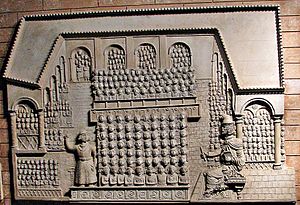
Back Талмудически академии във Вавилония Bulgarian Académies talmudiques en Babylonie French ישיבת פומבדיתא HE Вавилонские талмудические академии Russian
This article needs additional citations for verification. (January 2022) |

| Rabbinical eras |
|---|
The Talmudic academies in Babylonia, also known as the Geonic academies, were the center for Jewish scholarship and the development of Halakha from roughly 589 to 1038 CE (Hebrew dates: 4349 AM to 4798 AM)[citation needed] in what is called "Babylonia" in Jewish sources, at the time otherwise known as Asōristān (under the Sasanian Empire) or Iraq (under the Muslim caliphate until the 11th century). It is neither geopolitically, nor geographically identical with the ancient empires of Babylonia, since the Jewish focus of interest has to do with the Jewish religious academies, which were mainly situated in an area between the rivers Tigris and Euphrates and primarily between Pumbedita (modern Fallujah, a town west of Baghdad), and Sura, a town farther south down the Euphrates.
The key work of these academies was the compilation of the Babylonian Talmud, started by Rav Ashi and Ravina, two leaders of the Babylonian Jewish community, around the year 550. Editorial work by the Savoraim or Rabbanan Savoraei (post-Talmudic rabbis), continued on this text for the next 250 years. In fact, much of the text did not reach its final form until around 700.[1] The two most famous academies were located at Sura and Pumbedita; the Sura Academy was originally dominant, but its authority waned towards the end of the Geonic period and the Pumbedita Academy's Geonate gained ascendancy.[2] Major yeshivot were also located at Nehardea and Mahuza (al-Mada'in).
For the Jews of late antiquity and the early Middle Ages, the yeshivot of Babylonia served much the same function as the ancient Sanhedrin, i.e., as a council of Jewish religious authorities. The academies were founded in pre-Islamic Babylonia under the Zoroastrian Sasanians and were located not far from the Sassanid capital of Ctesiphon, which at that time was the largest city in the world.[3] After the Muslim conquest of Persia in the seventh century, the academies subsequently operated for four hundred years under the Islamic caliphate.
The first gaon of Sura, according to Sherira Gaon, was Mar Rab Mar, who assumed office in 609. The last gaon of Sura was Samuel ben Hofni, who died in 1034; the last gaon of Pumbedita was Hezekiah Gaon, who was tortured to death in 1040; hence the activity of the Geonim covers a period of nearly 450 years. The Geonim[4] (Hebrew: גאונים) were the presidents of the two great rabbinical colleges of Sura and Pumbedita, and were the generally accepted spiritual leaders of the worldwide Jewish community in the early Middle Ages, in contrast to the Resh Galuta (Exilarch) who wielded secular authority over the Jews in Islamic lands.
The three centuries in the course of which the Babylonian Talmud was developed in the academies founded by Rav and Samuel were followed by five centuries during which it was zealously preserved, studied, expounded in the schools, and, through their influence, recognized by the whole diaspora. Sura and Pumbedita were considered the only important seats of learning: their heads and sages were the undisputed authorities, whose decisions were sought from all sides and were accepted wherever Jewish communal life existed.
- ^ See Eras within Jewish law.
- ^ cf. Louis Ginzberg in Geonica.
- ^ Rosenberg, Matt T. (2007). "Largest Cities Through History". New York: about.com. Archived from the original on 2016-08-18. Retrieved 2007-11-14.
- ^ (also Gaonim, Geonim is the plural of גאון (Gaon), which means "pride" or "splendour" in biblical Hebrew and since the 1800s "genius" as in modern Hebrew. As a title of a Babylonian college president it meant something like "His Excellency."